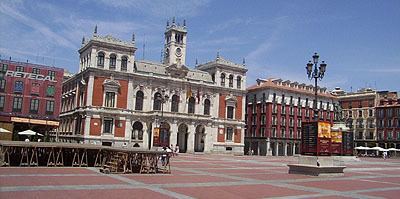 | ||
A plaza /ˈplɑːzə/ is an open urban public space, such as a city square.
Contents
Throughout Spanish America and the Spanish East Indies, the plaza mayor of each center of administration held three closely related institutions: the cathedral, the cabildo or administrative center, which might be incorporated in a wing of a governor's palace, and the audiencia or law court. The plaza might be large enough to serve as a military parade ground. At times of crisis or fiesta, it was the space where a large crowd might gather. Like the Italian piazza, the plaza remains a center of community life that is only equaled by the market-place.
Most colonial cities in Spanish America and the Philippines were planned around a square plaza de armas, where troops could be mustered, as the name implies, surrounded by the governor's palace and the main church. A plaza de toros is a bullring.
In modern usage, a plaza can be any gathering place on a street or between buildings, a street intersection with a statue, etc. Today's metropolitan landscapes often incorporate the "plaza" as a design element, or as an outcome of zoning regulations, building budgetary constraints, and the like. Sociologist William H. Whyte conducted an extensive study of plazas in New York City: his study humanized the way modern urban plazas are conceptualized, and helped usher in significant design changes in the making of plazas.
Etymology of "plaza"
Plaza (Castilian Spanish: [ˈplaθa]; or, Latin American Spanish: [ˈplasa]) is a Spanish word, cognate to Italian piazza, Portuguese praça, Galician praza, Catalan plaça, Romanian piața, German Platz and French place (which has also been borrowed into English). The origin of all these words is, via Latin platea, from Greek πλατεῖα (ὁδός) plateia (hodos), meaning "broad (way or street)".
Buildings called 'Plaza'
The first purpose-built shopping center in the United States, opened in Kansas City, Missouri in 1922, knowingly took the name of "Country Club Plaza" and adopted Spanish architectural details. More recently plaza has been used to describe a shopping complex, similar to a shopping mall, borrowing its connotations of a center of cultural life. The name is currently even applied to a single building with some semi-public street-level areas, often with a hotel or office tower above, while mall more often refers to multiple buildings or a street.
Examples: Pantip Plaza (Bangkok), Bintang Plaza (Miri), Kuching Plaza (Kuching), Plaza Las Américas (San Juan), Plaza de las Estrellas (Mexico City), Central Plaza (Hong Kong), Schiphol Plaza (Amsterdam), Plazas del Centro Comercial Santafé (Bogotá), The Plaza (Evergreen Park, Illinois), and Cityplaza, (Hong Kong).
Central Plaza, in Hong Kong, was for four years the tallest building in Asia, at 78 storeys, 374 m (1,227 ft).
